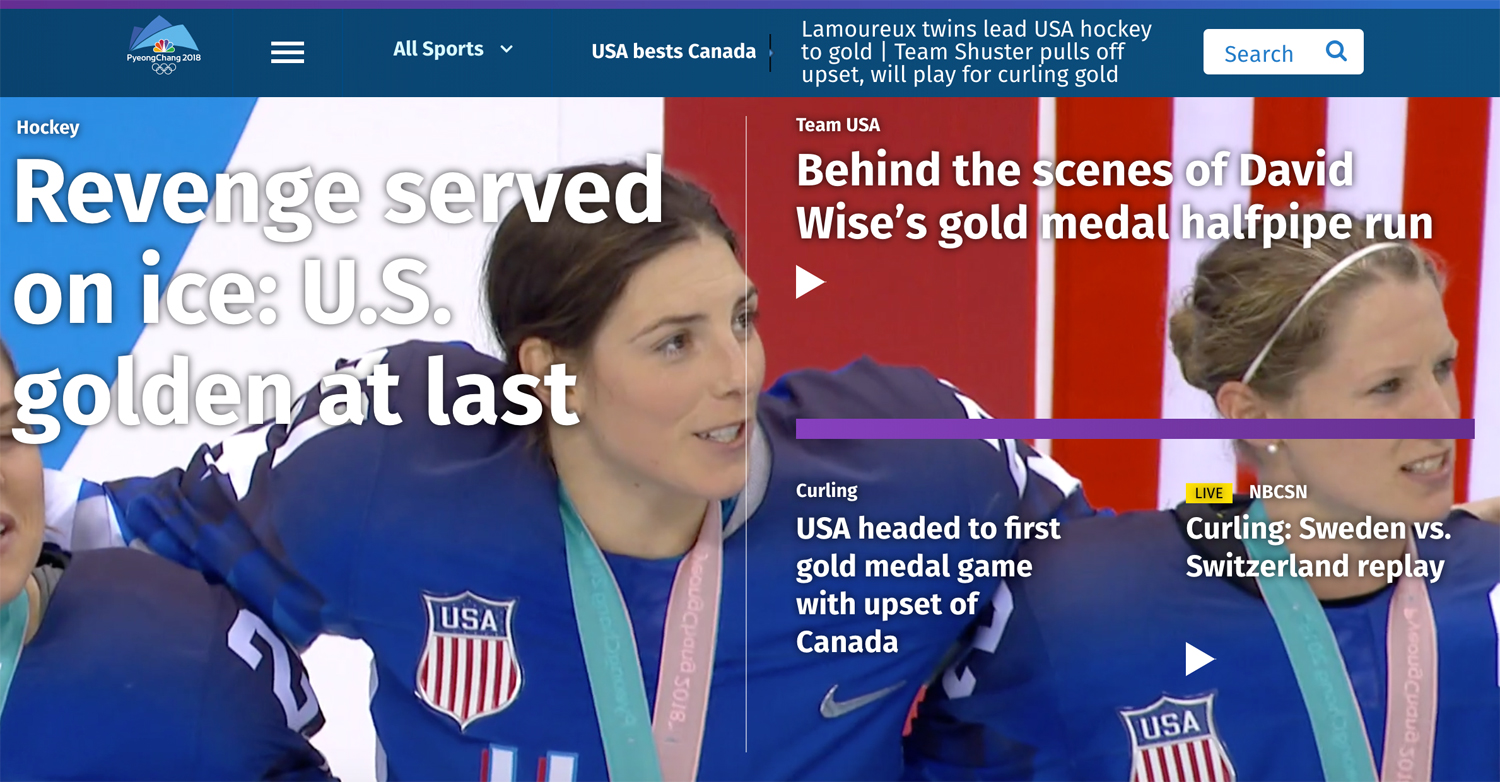Live From PyeongChang: As Streaming Numbers Soar, Connected Devices are the Breakout Star for NBC Olympics
“Enhanced Viewing Experience” adds informative, interactive touch to digital device UI
Despite the worries regarding the dramatic time-zone shift coming into these Winter Games (PyeongChang is a full 14 hours ahead of the Eastern time zone), NBC Olympics in the U.S. has blown its streaming numbers out of the water.

For the PyeongChang Winter Olympics, NBCOlympics.com and the NBC Sports app have already tripled the number of live-streamed events it logged at the 2014 Sochi Games.
In numbers reported by NBC Sports (which it attributes to Adobe Analytics), viewers logged a whopping 1.31 billion live-streaming minutes on NBCOlympics.com and through the NBC Sports app as of Feb. 18. That number triples the same metric from the whole 2014 Sochi Winter Olympics — with more than a week to spare. In addition, there were 11.6 million unique views as of the same date, up 174% from Sochi (4.3 million).
Things are going well. But, outside of the natural growth in usership of authenticated live-streaming apps over the past four years, what’s the deal? In the eyes of execs at NBC Olympics, the key reason for the explosion in digital viewers is connected TV. Devices like Apple TV, Roku, and Amazon Fire — none of which, mind you, even existed during the previous Winter Games — are providing an easy-to-navigate environment and a lean-back experience on one’s home television screen.
“We’ve been blown away by connected,” says Rick Cordella, EVP/GM, digital media, NBC Sports Group. “Historically, the Olympics have seen our ‘primetime’ audience come in around noon on a weekday, when everyone’s taking their lunch break. Now it’s shifted with connected TVs, where we are mirroring what [linear] TV is seeing. So our peaks are at night in primetime, they’re on Saturday and Sunday, and we have a large number of people streaming tape-delayed coverage on NBCSN, which has never happened before.”

NBC Sports Group’s Rick Cordella says use of connected-TV devices has been a boon to this Olympics’ streaming numbers.
Cordella notes that the app experience on a phone or laptop is great for viewing on the go but tends to deliver shorter use times. Through the connected-TV devices, users are more likely to throw an event on their big screen and consume content for longer stretches.
“If you think about the different platforms, desktop and mobile,” he says, “you seek out content. You know it’s there, you know what you want to watch, you want to go find it, you watch it, and you’re done. Now we’re seeing the sort of lean-back experience of TV with all the connected devices. Like I mentioned, we had a few hundred thousand people watching NBC’s taped coverage on a Sunday afternoon. We’re saying, Wow, never seen that before. That’s been the big change.”
Delivering the Experience
For all of its international rightsholding broadcasters, host broadcaster Olympic Broadcasting Services (OBS) produces a white-label version of a live-streaming app that can be taken and directly delivered to consumers. Major broadcasters like NBC Sports, however, choose instead to take OBS’s package of APIs (application-programming interfaces) and SDKs (software-development kits) in order to plug the live-streaming video and event data directly into its own existing app. The obvious benefit is that many viewers may already have the NBC Sports app on their device and the network wins with the branding and exposure that comes with pushing new users to a primary app. Plus, it takes a major effort to get a user to download a new app for a two-week event, and then, with a one-off white-label app, the broadcaster loses all of that valuable user data when the event is over.
“A big thing for us was, the Super Bowl was just three days prior [to the start of the Olympics],” notes Cordella. “So you have all these new people coming in and downloading the [NBC Sports] app. We obviously had an enormous audience for the Super Bowl, and we actually have seen a pretty good crossover of that audience back with us at the Olympics. I think it benefited us having that happening just three days in advance.”
On the backend, NBC Olympics’ live-streaming experience is a product of NBC Sports’ Playmaker Media and its technology partner iStreamPlanet. More than 75 staffers work through the night at NBC Sports’ facility in Stamford, CT, to support and QC the technology of the live-streaming product.
Plus, the Olympics aren’t happening in a silo for NBC Sports. Its other properties — including the NFL, NHL, and Premier League — continue to test the infrastructure’s capabilities on a nightly basis.
“It’s all still powered by the same technology stack,” says Eric Black, chief technology officer, NBC Sports Digital and Playmaker Media. “It’s really just a balance of volume and, frankly, overnights since our staff is largely [in Stamford] from 8 p.m. ET on. The volume and the concurrency of what we’re doing is pretty on-par with what we see on most of our weekends. The difference is, it’s every night for 17 straight nights. That’s where the challenges lie.”
Enhancing the Experience
Users may have noticed a few enhancements to this Olympics’ streaming experience. NBC Sports is calling it “Enhanced Viewing Experience” because the network leverages its archived media assets and data feeds coming in from OBS to provide a more informative and interactive UI.
During the primetime show, viewers are welcomed with a slate of information, including a rundown of the events and athletes to be featured that night. ChyronHego Lyric Pro graphics-creation software is used to create and insert the dynamic, reactive “cards.” For example, during a live figure-skating stream, users would be able to access “cards” with data like the upcoming order of skaters, medal counts, and individual skater info with video highlights.
“We have a massive database of facts, insights, and research,” explains Jack Jackson, VP, digital product development, NBC Sports Group. “It’s all about getting the athletes out of the helmets and goggles and connecting them with the fans.”
NBC Sports is also using chapter markers (available on most platforms) on the live-streaming timeline to make the navigation of longform/live content simpler for users. With a graphic-interface point, viewers can easily track back to the start of a race or identify where a favorite athlete’s run took place in the stream.
NBC Digital is also using a Blackmagic Design switcher to offer access to bonus camera angles — on such spots as the warmup room, the coach’s box, or the “kiss and cry” — at appropriate times.
Jason Dachman contributed to this report.
For more of our coverage from the PyeongChang Winter Olympic Games, including interviews, videos, podcasts, and more, visit our SportsTech Live Blog.
